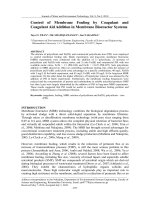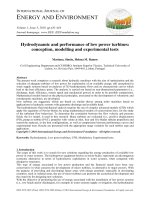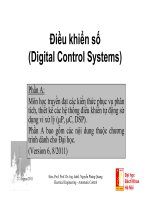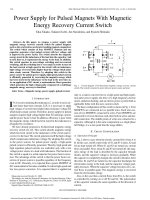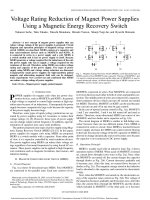Electronics - Digital Control of Switching Power Supply
Bạn đang xem bản rút gọn của tài liệu. Xem và tải ngay bản đầy đủ của tài liệu tại đây (407.56 KB, 11 trang )
Digital Control of Switching Power Supply
- Power Factor Correction Stage
Sangsun Kim and Dr. P. Enjeti
Power Electronics and Power Quality Laboratory
Department of Electrical Engineering
Texas A&M University
College Station, TX – 77843-3128
Tel: 979-845-7466
Fax: 979-845-6259
Email:
Abstract: Industry standard for the control of switch mode power supply (SMPS) systems has been
analog control. Now with the advent of high speed, lower cost digital signal processing (DSP) ICs,
digital control there has been an increased interest in digital control of SMPS. The Power
Electronics & Power Quality Laboratory of Texas A&M University is currently exploring several
implementation aspects of digital control of power factor correction (PFC) stage of SMPS. Two low
cost digital controllers: TMS320LF2407 and ST52x420 are evaluated for implementing PFC
function. Simulation and experimental results are shown to demonstrate PFC control of SMPS to
meet IEC 1000-3 harmonic limits.
I. Introduction
Worldwide, the markets of internal and external switch mode ac/dc power supply (SMPS) have
been growing at a faster rate for several applications such as communications, computers,
instrumentation, Industrial controls, and military/aerospace area [1, 2]. According to resent
estimates, the world wide SMPS market share for power supplies (notebook computer, cellular
phone, modem, and telecommunication equipment) is expected to increase from about $20 billion
in 2000 to $56 billion by 2005, for a compound annual growth rate 23.2 %. The majority of the
present day SMPS employ analog control and are undergoing slow evolution. On the other hand,
enabling technologies such as digital signal processors (DSP), integrated semiconductors,
magnetics, improved power components, and cooling technologies are fast evolving. Tomorrow’s
SMPS is expected to be highly efficient, with near unity power factor, DSP control, 10W per cubic
inch, and 400+A in the same size as 200A today. In response to the concerns, this article evaluates
the feasibility employing state of the art digital control of power factor correction stage with fuzzy
logic algorithm.
A conventional SMPS employs a diode rectifier for ac to dc conversion. This type of utility
interface generates harmonics and the input power factor (PF) and total harmonic distortion (THD)
are poor. IEC 1000-3 and IEEE 519 standards specify link as harmonic compliance and THD. To
comply with the corresponding standards in Europe and North America several active solutions
have been proposed [2] and widely studied in the literature, being most usually employed the boost
converter. The design of the switching power supply requires many features such as:
1. Lower input current harmonics to meets the IEC 1000-3 harmonic limits.
2. High input power factor to minimize reactive requirements.
3. Minimum conducted EMI.
Up to now, the demands for digital processor have been increased due to its low cost, high speed
operation, and flexibility. In this article, several implementation aspects of digital control of power
factor correction (PFC) stage of SMPS are explored. 16-bit fixed point DSP, TMS320LF2407, is
evaluated for implementing PFC function. To further reduce the cost and implement fuzzy logic
control for PFC, 8-bit micro-controller, ST52x420, is employed. Simulation and experimental
results are shown to demonstrate PFC control of SMPS to meet IEC 1000-3 and IEEE 519 harmonic
limits.
II. Analog and Digital Control
Traditionally, the implementation of switching power supply has been accomplished by using
analog power factor correction (PFC) as shown in Fig. 1 [3]. Analog PFC IC's which are
manufactured by TI/Unitrode, Fairchild, and STmicroelectronics are available and have been able to
provide improved power factor. Analog control can provide continuous processing of signal, thus
allowing very high bandwidth. It also gives infinite resolution of the signal measured. Analog
control, however, also posses some drawbacks such as a number of parts required in the system and
their susceptibility to aging and environment variations, which lead to high cost of maintenance.
Further, analog control once designed is inflexible and performance cannot be optimized for various
utility distortions. In the view of these, this article explores digital implementation of switch mode
power supply via digital control. Digital control provides advantages such as programmability, less
susceptibility to environmental variations, and fewer part counts [2]. It also reduces the size of the
power supply by containing the complexity of control system within the software. Therefore, since
digital control is much flexible than analog control, is becoming lower cost, and applicable for
Utility LC filter Diode Rectifier Boost Converter Load
+
_
L
o
a
d
+
_
V
i
V
S
i
S
L
S
C
S
i
dr
L
dr
V
dr
C
dc
V
dc
V,i
Voltaage
Regulator
| |
+
_
Current
Regulator
+
_
Gate input
*
dr
i
*
dc
V
D
i
dr
V
dc
Analog IC : UC3854(TI/Unitrode), ML4812(Fairchild), L6561(STM)
Fig. 1 Power factor corrected boost converter with analog control.
Utility LC filter Diode Rectifier Boost Converter Load
+
_
L
o
a
d
+
_
V
S
i
S
L
S
C
S
i
dr
L
dr
V
dr
C
dc
V
dc
Gate input
D
i
dr
V
dc
V
S
DSP Control
Fig. 2 Digital control of PFC Boost Converter.
intelligent control, it can be employed for power supply applications as shown in. Fig. 2. In order to
obtain high speed bandwidth of the fixed point DSP, TMS320LF2407, numerous off-line
computations are first performed and the outputs of the controller based on fuzzy logic rules are
stored in a memory block. Further low cost implementation on an 8-bits micro-controller,
ST52x420, along with ST-Fuzzy Studio is explored and achieved.
III. Operation Concept and Analysis
Normally, diode rectifier system contains a lot of harmonic contents such as 3
rd
, 5
th
, 7
th
, etc. as
shown in Fig. 3. To improve the input THD, the additional PFC boost converter in the system is
employed. Due to the rectified voltage
dr
V and the characteristic of diode rectifier current, a
disturbance is considered as,
*
dc
dr
*
dc
V
VV
D
−−
==
, (2)
where, D is the duty ratio of the boost converter controlled by open-loop control. The duty ratio
PI
D
by closed loop PI control is obtained from the control block diagram which consists of dc
voltage and current controllers and the disturbance as shown in Fig. 4. Since the duty ratio D
has a
reverse waveform of the rectified voltage
dr
V to make input current sinusoidal as shown in Fig. 5,
lower and higher harmonic components are obtained from D and
PI
D , respectively. Therefore,
higher bandwidth of the whole control system can be achieved with lower bandwidth of current PI
controller.
L
o
a
d
V
S
i
L
V
dc
(a) Diode rectifier system
(b) Utility current and voltage
0
0.2
0.4
0.6
0.8
1
1.2
1 3 5 7 9 11 13 15 17
Harmonic order (
h
)
Ih/I1
(c) Harmonics of diode rectifier current
Fig. 3 The concept of power factor correction.
PI
| |
+
_
+
_
PI Current
Regulator
+
+
Duty Ratio
÷÷
Disturbance
t
e
ωsin
*
dr
i
dr
i
+
_
dr
V
*
dc
V
dc
V
D
D
PI
D
Fig. 4 Control block diagram for the proposed PFC boost converter.
(a) D
and
PI
D
(b) Duty ratio D
(c) Utility voltage and current
Fig. 5 The waveforms of control system parameters.
